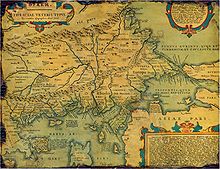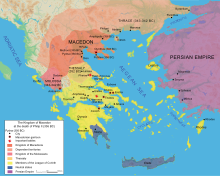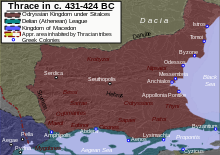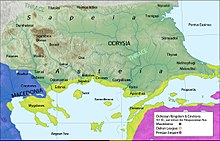Cotys I or Kotys I was a king of the Odrysians in Thrace from 384 BC to his murder in 360 BC. He was known to have been born during the reign of Seuthes I, based on ancient sources and date of birth estimates for Cotys, his daughter who married the Athenian general Iphicrates, and her son Menestheus. According to Harpokration, he reigned for 24 years, which places his accession in 384 BC. Although his origins are actually unknown, An Athenian inscription dated to 330 BC, which honors Reboulas, brother of Cotys and son of king Seuthes. As the ordinal of Seuthes is not mentioned, it was unclear, however, which of the preceding kings named Seuthes is meant by the inscription. While scholars originally believed Seuthes II to be the father of Cotys I, now it is known that Seuthes I was his father, as Seuthes II was only 7 years old at the time of Seuthes I's abdication in 411 BC.
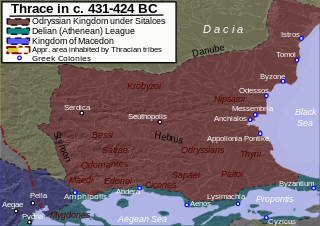
The Odrysian Kingdom was a state grouping many Thracian tribes united by the Odrysae, which arose in the early 5th century BC and existed at least until the late 1st century BC. It consisted mainly of present-day Bulgaria and parts of Southeastern Romania, Northern Greece and European Turkey. Dominated by the eponymous Odrysian people, it was the largest and most powerful Thracian realm and the first larger political entity of the eastern Balkans. Before the foundation of Seuthopolis in the late 4th century it had no fixed capital.
Cersobleptes, was son of Cotys I, king of the Odrysians in Thrace, on whose death in September 360 BC he inherited the throne.
Hebryzelmis was an Odrysian king of Thrace, attested as ruling in 386/385 BC.

Seuthes III was a king of Odrysia, a part of Thrace, during the late 4th century BC.

Asti is the name of a Thracian tribe which is mentioned by Livy. It is believed that they lived around the old Thracian capital of Bizye.

Rhoemetalces I (Sapaean) was king of the Sapaean kingdom of Thrace from 15 BC to 12 AD. He was king of Odrysian kingdom of Thrace in succession to his nephew Rhescuporis II (Astaean).
Rhescuporis II was king of the Sapaean kingdom of Thrace from 12 to 19 AD. He ruled half of the kingdom in succession to his brother Rhoemetalces I, and briefly ruler of the entire realm thereafter, usurping the other half from nephew Cotys VIII. He was a son of the earlier Thracian king Cotys VI and the younger brother of kings Cotys VII and Rhoemetalces I. The Roman Historian Tacitus describes his character as "treacherous".
Rhoemetalces II was a Client Ruler in association with his mother Antonia Tryphaena of the Sapaean kingdom of Thrace under the Romans. He ruled from 19 until 38 AD. On coinage his royal title is in Greek: ΒΑΣΙΛΕΩΣ ΡΟΙΜΗΤΑΛΚΟΥ or of King Rhoemetalces. Rhoemetalces II and Tryphaena succeeded his paternal great-uncle Rhescuporis II, who had usurped the throne from Rhoemetalces II's father Cotys VIII. The Roman Emperor Tiberius deposed Rhescuporis II and installed Rhoemetalces II and Tryphaena on the throne in his place. They served as loyal client rulers, even in 26 putting down Thracian malcontents for Tiberius. Rhoemetalces II never married and had no children. After his death in 38, his father's cousin Rhoemetalces III, the son of Rhescuporis II, was appointed king, while his mother retired to live as a private citizen in Cyzicus.

Sapaeans, Sapaei or Sapaioi were a Thracian tribe close to the Greek city of Abdera. One of their kings was named Abrupolis and had allied himself with the Romans. They ruled Thrace after the Odrysians until its incorporation by the Roman Empire as a province.
Teres II or Teres III was a king of the Odrysians in Thrace from 351 BC to 341 BC.
Cotys II was a possible king of the Odrysians in Thrace in the late 4th or early 3rd century BC. His one secure attestation is in an inscription from Athens dated to 330 BC; the inscription honored Reboulas, brother of Cotys and son of Seuthes. This is generally interpreted to mean that Cotys, not yet king, was the son of Seuthes III by a marriage earlier than that to Berenike. Building on this interpretation of the evidence, a certain Gonimase (Gonimasē), wife of a Seuthes, buried in a tomb near Smjadovo, has been proposed as Seuthes III's earlier wife and mother of Cotys and Reboulas. However, the Athenian inscription precedes the first clear attestation of Seuthes III by about seven years, and various scholars have proposed Seuthes I, Seuthes II, and even a non-reigning Seuthes as the father of Cotys and Reboulas. One scholar conjectures that Cotys was an elder son of Seuthes III but did not live to succeed his father, dying during the siege of Callatis (Mangalia) in 310 BC. While it is likely that Cotys II was a Thracian ruler in this period, it is not possible to establish his precise relationship to Seuthes III. The overall chronology and the names suggest the possibility that Cotys II may have been the father of Raizdos and grandfather of the latter's son Cotys III.
Cotys III was a king of the Odrysians in Thrace in the early 3rd-century BC. His one secure attestation is an inscription from Delphi dated to sometime between 276 and 267 BC, in which he is named as the son of Raizdos, his probable predecessor. Scholarship has long associated a coin type struck for a king Cotys on one side and a king Rhescuporis on the other and also a king Cotys, father of a Rhescuporis, named in a decree from Apollonia (Sozopol) with Cotys III. However, these identifications have been doubted, and some scholars have redated both the coin type and the inscription to almost three centuries later. It is therefore uncertain whether Cotys III was succeeded by a son named Rhescuporis.
Cotys IV was a king of the Odrysians in Thrace from before 171 until after 166 BC. He was the son of Seuthes V and succeeded either his father or another king, Amadocus III, who was captured by the Macedonians in 184 BC. While the survival of a specifically Odrysian state past the mid-3rd century has been doubted, Cotys IV is described as an Odrysian by Polybius and Livy, although the term may have been used in a less than specific sense.

Rhoemetalces III was a King of the Sapaean Thracians. He was the son of the Monarch Rhescuporis II. In association with his wife Pythodoris II, they were client rulers of the Sapaean kingdom of Thrace under the Romans from AD 38 to 46, in succession to Pythodoris’ mother Tryphaena and Pythodoris' brother Rhoemetalces II.
Cotys III was the Sapaean Roman client king of eastern Thrace from 12 to 18 AD.
Cotys I was a Sapaean client king of the Odrysian kingdom of Thrace from c. 57 BC to c. 48 BC. He was the son of Rhoemetalces.
Rhescuporis I was a possible king of the Odrysians in Thrace in the 3rd century BC. Scholarship has long associated a coin type struck for a king Cotys on one side and a king Rhescuporis on the other and also a king Cotys, father of a Rhescuporis, named in a decree from Apollonia (Sozopol) with the Odrysian rulers Cotys III and Rhescuporis I, However, these associations have been doubted, and some scholars have redated both the coin type and the inscription to almost three centuries later, when the same names and relationships appear again among the Astaean and Sapaean kings of Thrace. It is therefore uncertain whether Cotys III was succeeded by a son named Rhescuporis. If he was, the coin type struck for both kings would be the only certain proof that Rhescuporis reigned, because the Apollonia decree only mentions that he had spent time in the town as hostage on his father's behalf.
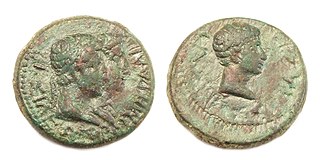
The Thracian kingdom, alternatively also the Sapaean kingdom, was an ancient Thracian state in the southeastern Balkans that existed from the middle of the 1st century BC to 46 AD. Succeeding the Classical and Hellenistic era Odrysian kingdom of Thrace, it was dominated by the Sapaean tribe, who ruled from their capital Bizye in what is now northwestern Turkey. Initially only of limited relevance, its power grew significantly in the ancient Roman world as a client state of the late Roman Republic. After the Battle of Actium in 31 BC, Octavian installed a new dynasty that proved to be highly loyal and expansive. Conquering and ruling much of Thrace on behalf of the Roman Empire, it lasted until 46 AD, when Emperor Claudius annexed the kingdom and made Thracia into a Roman province.
Seuthes V was a king of the Odrysians in Thrace in the late 3rd or early 2nd century BC. He is only known as the father of Cotys IV, who is attested between 171 and 166 BC as an ally first of Antigonid Macedon, then of Rome. The Roman historian Livy specifically describes Cotys and his father Seuthes as Odrysians. Livy's statement that in its diplomatic interaction with Cotys IV the Roman Senate referenced a traditional friendship with Cotys and his ancestors can be interpreted as evidence for contact between Rome and Seuthes V. Seuthes V is believed to have reigned around the year 200 BC as a predecessor or rival of Amadocus III, who was captured by the Macedonians in 184 BC. The chronology and names suggest that he may have been a son of Roigos and grandson of Seuthes IV or a son of Teres IV and grandson of Seuthes IV, depending on the chronological placement of Roigos in the middle or beginning of the 3rd century BC.
